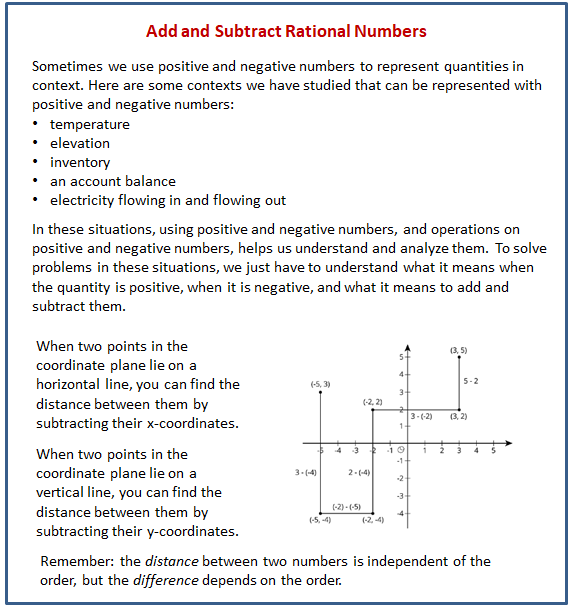Illustrative Mathematics Grade 7, Unit 5, Lesson 7: Adding and Subtracting to Solve Problems
Learning Targets:
- I can solve problems that involve adding and subtracting rational numbers.
Related Pages
Illustrative Math
Grade 7
Lesson 7: Adding and Subtracting to Solve Problems
Let’s apply what we know about signed numbers to different situations.
Illustrative Math Unit 7.5, Lesson 7 (printable worksheets)
Lesson 7 Summary
The following diagram shows how to solve problems that involve adding and subtracting rational numbers.

Lesson 7.1 Positive or Negative?
Without computing:
- Is the solution to -2.7 + x = -3.5 positive or negative?
- Which of the following are solutions to -2.7 + x = -3.5?
-3.5 + 2.7
3.5 - 2.7
-3.5 - (-2.7)
-3.5 - 2.7
Lesson 7.2 Phone Inventory
A store tracks the number of cell phones it has in stock and how many phones it sells. The table shows the inventory for one phone model at the beginning of each day last week. The inventory changes when they sell phones or get shipments of phones into the store.
- What do you think it means when the change is positive? Negative?
- What do you think it means when the inventory is positive? Negative?
- Based on the information in the table, what do you think the inventory will be at on Saturday morning? Explain your reasoning.
- What is the difference between the greatest inventory and the least inventory?
Lesson 7.3 Solar Power
Han’s family got a solar panel. Each month they get a credit to their account for the electricity that is generated by the solar panel. The credit they receive varies based on how sunny it is.
In January they used $83.56 worth of electricity and generated $6.75 worth of electricity. Here is their electricity bill from January.
Current charges: $83.56
Solar Credit: -$6.75
Amount due: $76.81
- In July they were traveling away from home and only used $19.24 worth of electricity. Their solar panel generated $22.75 worth of electricity. What was their amount due in July?
- The table shows the value of the electricity they used and the value of the electricity they generated each week for a month. What amount is due for this month?
- What is the difference between the value of the electricity generated in week 1 and week 2? Between week 2 and week 3?
Are you ready for more?
While most rooms in any building are all at the same level of air pressure, hospitals make use of “positive pressure rooms” and “negative pressure rooms.” What do you think it means to have negative pressure in this setting? What could be some uses of these rooms?
Lesson 7.4 Solar Power Differences and Distances
Plot these points on the coordinate grid: A = (5, 4), B = (5, -2), C = (-3, -2), D = (-3, 4)
Open Applet
- What shape is made if you connect the dots in order?
- What are the side lengths of figure ABCD?
- What is the difference between the x-coordinates of B and C?
- What is the difference between the y-coordinates of C and B?
- How do the differences of the coordinates relate to the distances between the points?
Lesson 7 Practice Problems
- Tyler orders a meal that costs $15.
a. If the tax rate is 6.6%, how much will the sales tax be on Tyler’s meal?
b. Tyler also wants to leave a tip for the server. How much do you think he should pay in all? Explain your reasoning. - In a video game, a character is healed at a constant rate as long as they are standing in a certain circle. Complete the table.
- a. How much higher is 500 than 400 m?
b. How much higher is 500 than -400 m?
c. What is the change in elevation from 8,500 m to 3,400 m?
d. What is the change in elevation between 8,500 m and -300 m?
e. How much higher is -200 m than 450 m? - The table shows four transactions and the resulting account balance in a bank account, except some numbers are missing. Fill in the missing numbers.
- The departure from the average is the difference between the actual amount of rain and the average amount of rain for a given month.
The historical average for rainfall in Albuquerque, NM for June, July, and August is shown in the table.
a. Last June only 0.17 inches of rain fell all month. What is the difference between the average rainfall and the actual rainfall for last June?
b. The departure from the average rainfall last July was -0.36 inches. How much rain fell last July?
c. How much rain would have to fall in August so that the total amount of rain equals the average rainfall for these three months? What would the departure from the average be in August in that situation?
The Open Up Resources math curriculum is free to download from the Open Up Resources website and is also available from Illustrative Mathematics.
Try the free Mathway calculator and
problem solver below to practice various math topics. Try the given examples, or type in your own
problem and check your answer with the step-by-step explanations.

We welcome your feedback, comments and questions about this site or page. Please submit your feedback or enquiries via our Feedback page.